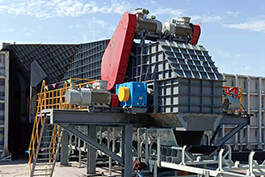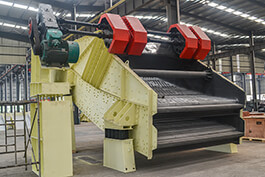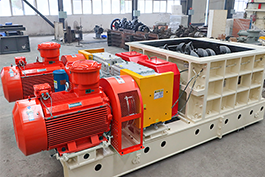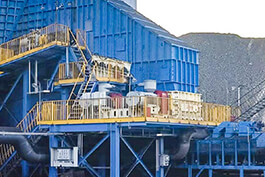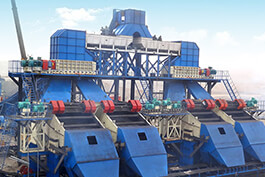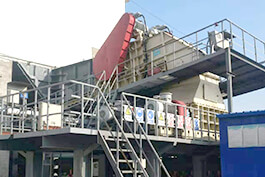An overview of Mineral sizer
Mineral sizer is designed to meet the requirements of large processing capacity and high efficiency in coal production. The so-called Mineral sizer refers to the process where the material in the feed that meets the required size for discharge is directly discharged through a crusher without further crushing. Crushing materials larger than the output particle size achieves the dual effects of screening and crushing.
It features a high caking rate, less overcrushing, large processing capacity and energy conservation. With the development of classification crushing technology and the improvement of the manufacturing level of crushing equipment, the application of mineral sizer has become increasingly widespread. In non-coal industries, Mineral sizer has found good application in the processing of raw materials in the chemical field, such as the crushing of limestone and alumina ores. The Mineral sizer has a simple structure and good equipment stability, making it suitable for installation and use in industrial and mining enterprises.
The application scope of Mineral sizer mainly lies in the medium and coarse crushing operations of ores with a crushing strength of less than 250MPa, and it is more suitable for usage environments with high requirements for block rate. Mineral sizer has a very successful experience in limestone mines, with an extremely low equipment failure rate, large processing capacity and high caking rate, meeting the demand for limestone as a chemical raw material.
The current problems faced by limestone ore crushing
Severe overcrushing
For the chemical industry that uses limestone as raw material, quicklime is an inevitable step in its transformation process. During the preparation of quicklime, the particle size of the limestone raw material is strictly required, generally around 40 to 80mm. If it is too small, it is prone to overburning; if it is too large, it will not burn through thoroughly.
For the jaw crusher, it mainly relies on extrusion crushing. During the crushing process of the jaw crusher, regardless of whether the particle size meets the requirements or not, it will be squeezed. Due to multiple extrusions, over-crushing will occur between the jaw plate and the material, as well as between materials themselves. The proportion of over-crushing increases as the required particle size decreases.
According to statistics from production practice, the yield of 40 to 80mm only accounts for about 30%, indicating severe overcrushing. Therefore, the jaw crusher is not suitable as the final particle size control equipment for crushing operations with a requirement for the caking rate. It is only applicable to the coarse crushing stage with an output particle size of about 250mm.
Poor adaptability of processing capacity
For the ring hammer crusher, it mainly adopts impact crushing. Under the impact of the high-speed rotating hammer heads, the materials are crushed by impact. The rotor speed increases as the rotor diameter decreases, generally ranging from 300 to 3000r/min, which is very fast.
According to the theory of rock fracture mechanics, the fragmentation of rocks is caused by the expansion and merging of internal defects and cracks in the rocks, and the rate of external force loading leads to changes in the rate of defect and crack merging. With the increase of the external force loading rate, the combination of defects and cracks decreases, the free diffusion and quantity increase, and the number of broken rock blocks increases.
Therefore, the fast speed of external force loading leads to an increase in over-crushing. According to statistics in practice, the crushing rate and block formation rate of the ring hammer crusher are similar to those of the jaw crusher. Moreover, due to the structural reasons of the ring hammer crusher, its discharge speed is slow and its processing capacity is low, making it unsuitable for use in large-scale limestone mines.
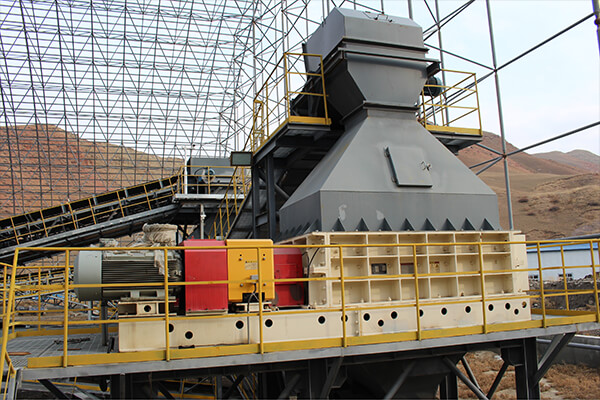
The advantages of Mineral sizer in limestone mines
Reduce over-crushing
The mechanism of Mineral sizer is different from the above-mentioned crushers. During the working process of Mineral sizer, due to the fact that the crushing teeth on the crushing roller are spirally arranged along the axial direction, the materials are automatically distributed from the middle to both ends under the action of the crushing roller, which can prevent the accumulation and mutual squeezing of materials.
Therefore, after the raw materials enter the Mineral sizer, the materials that meet the particle size requirements are directly discharged along the enclosed space between the crushing teeth, reducing the occurrence of overcrushing.
The forced discharge function of the crushing teeth on the material is beneficial to enhancing the processing capacity of the Mineral sizer. Meanwhile, as the rotational speed of the crushing roller is only a few dozen revolutions per minute, it can effectively reduce the occurrence of overcrushing.
For materials that exceed the particle size requirements, they are crushed through shearing, stretching, bending, puncturing, breaking, splitting and other actions under the action of interlaced crushing teeth. Materials that meet the particle size requirements are directly discharged. Materials that temporarily do not meet the particle size requirements are flipped over by the crushing teeth and then enter the crushing stage of the next crushing tooth until all materials meet the particle size requirements.
Block formation rate and particle size control
The application of Mineral sizer in limestone mines has met the requirements for caking rate and equipment stability. A comparison of the caking rate between the jaw crusher originally used and the current classification crusher.
The particle size of the material entering the crusher is 250 to 80mm, and the limestone particle size is required to be 40 to 80mm. It can be seen that both types of equipment have products that exceed the particle size requirements. For Mineral sizer, the size in both directions can be strictly controlled.
For materials that meet the particle size requirements in both directions but have a small amount of deviation in one direction, due to the feeding Angle, they may directly leak between the crushing rollers. The jaw crusher also has similar problems. Meanwhile, it has a yielding mechanism, so there will be more over-sized products.
In fact, whether it is coal or limestone, which are medium to low hardness and high brittleness materials, Mineral sizer can maintain a high caking rate and uniform particle size. The proportion of Mineral sizer in the 40-20mm and 20-0mm particle sizes is relatively small. The appearance of products with smaller particle sizes is due to the large pieces of products falling off during the crushing process or being directly crushed. For some enterprises, over-crushed materials are equivalent to tailings and must be strictly avoided.
Mineral sizer has a significant advantage in controlling the caking rate and overcrushing. Both in terms of design principles and production practices, it is more suitable than the crushers used in the construction industry to ensure the particle size of the products. Therefore, Mineral sizer is highly suitable for use as the final product particle size control equipment, enhancing the yield of limestone mining product blocks.
The benefits generated by Mineral sizer
Reduce pollution and waste
At present, in the limestone industry, 80-40mm blocks are the products with the highest profit margin, but their yield is only around 30%. Products with smaller particle sizes have lower prices and sales volumes, thus leading to environmental problems such as resource waste, low efficiency, and tailings accumulation. Mineral sizer can increase the caking rate by 20%, with obvious economic benefits. At the same time, it can also reduce social and environmental problems such as dust pollution and tailings accumulation.
Material compatibility
The successful application of Mineral sizer for coal in the limestone industry depends on the similarity of coal and limestone materials. In coal mining enterprises, although the crushing strength of clean coal is below 120MPa, the raw coal mined contains a certain amount of gangue, which is diverse in types, including white sandstone, igneous rocks, and even hard rocks such as basalt, with compressive strengths ranging from 160 to 250MPa. In contrast, the compressive strength of limestone is around 130MPa. Therefore, coal Mineral sizer is fully capable of being applied in the limestone mining industry. With the gradual development and consumption of limestone resources, the refined utilization of limestone ores and the demand for multiple particle sizes of products will surely be given due attention. Mineral sizer, with its excellent particle size control ability, will also be fully utilized in the limestone industry production.
Summary
With the development and consumption of limestone resources, the industry's demand for refined utilization of ores and customized products of multiple particle sizes has been continuously increasing. Mineral Sizer has proven its application value in limestone mines with its core advantages of precise particle size control, high caking rate and high stability.



